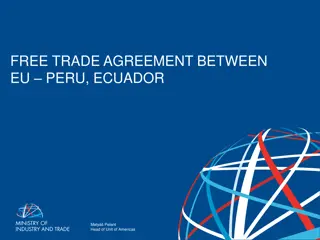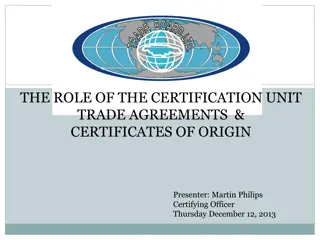Understanding Rules of Origin in Trade Agreements
Rules of origin play a crucial role in determining the national source of a product, certifying its origin, and securing preferential treatment under trade agreements. This includes defining where goods are produced and how they are made, with specific criteria for each case. Preferential rules of origin are essential for granting tariff preferences and ensuring compliance with trade agreements. Key features include distinguishing wholly obtained products and those from imported materials, along with specific criteria to determine origin. The EU-SADC EPA Protocol lists examples of wholly obtained goods to streamline trade relations.
Download Presentation

Please find below an Image/Link to download the presentation.
The content on the website is provided AS IS for your information and personal use only. It may not be sold, licensed, or shared on other websites without obtaining consent from the author. Download presentation by click this link. If you encounter any issues during the download, it is possible that the publisher has removed the file from their server.
E N D
Presentation Transcript
EU-SADC EPA Rules of Origin Mission to Lesotho and Swaziland 14-20 March 2018 Roberto Cecutti Trade Affairs Officer for SADC EPA implementation European Commission Directorate-General for Trade Unit D.2 Economic Partnership Agreements Africa, Caribbean and Pacific, Overseas Countries and Territories
Definition of origin of goods A link between a good/product and a country or territory, through: - the location of its production: territoriality of origin( where the goods are made ) - the conditions of its production: acquisition of origin( how the goods are made ) Rules of origin provide the method and criteria to determine the national source of a product and the procedures to certify and verify it.
Use of origin for preferential purposes: Preferential rules of origin are those laws, regulations and administrative determinations of general application applied by any Member to determine whether goods qualify for preferential treatment under contractual or autonomous trade regimes leading to the granting of tariff preferences (WTO Agreement on Rules of Origin)
Use of origin for preferential purposes Preferential tariff measures resulting from: preferential trade agreements (free trade agreements, EPAs) in accordance with GATT XXIV preferential trade autonomous arrangements (e.g. GSP) including: preferential tariff quotas preferential origin derogation quotas
Key features of all Rules of Origin Distinction between: products wholly obtained in a country products resulting from the transformation in a country of imported materials Existence of a list of wholly obtained products Existence of principles and/or positive criteria ( list rules or PSR, product specific rules ) to determine the origin of products obtained from imported materials Possible negative test of minimal operations Declaration of the origin of goods on import
List of wholly obtained goods in EU-SADC EPA Protocol 1 Article 7 (a)mineral products extracted from their soil or from their seabed; (b) fruit and vegetable products harvested there; (c) live animals born and raised there; (d) products from live animals raised there; (e) products from slaughtered animals born and raised there; (f) (i) products obtained by hunting or fishing conducted there; (ii) Products of aquaculture, where the fish, crustaceans, molluscs and other aquatic invertebrates are born or raised there from eggs, larvae or fry; (g) products of sea fishing and other products taken from the sea outside the territorial waters of the EU or of the SADC EPA States by their vessels; (h) products made aboard their factory ships exclusively from products referred to in point (g); Etc.
List of working or processing required to confer originating status to non-originating materials in EU-SADC EPA Protocol 1 Annex 2 (Product Specific Rules PSR) . Example: HS heading 2007:Jams, fruit jellies, marmalades, fruit or nut pur e and fruit or nut pastes, obtained by cooking, whether or not containing added sugar or other sweetening matter Manufacture in which: all the materials used are classified within a heading other than that of the product; the value of any materials of Chapter 17 used does not exceed 30 % of the ex works price of the product ex 2008 Nuts, not containing added sugar or spirit Manufacture in which the value of the originating nuts and oil seeds of heading Nos 0801, 0802 and 1202 to 1207 used exceeds 60 % of the ex works price of the product
List of minimal operations in EU-SADC EPA Protocol 1 Article 9 (a) preserving operations to ensure that the products remain in good condition during transport and storage; (b) breaking up and assembly of packages; (c) washing, cleaning; removal of dust, oxide, oil, paint or other coverings; (d) ironing or pressing of textiles; (e) simple painting and polishing operations; (f) husking, partial or total bleaching, polishing, and glazing of cereals and rice; (g) operations to colour sugar or form sugar lumps; partial or total milling of crystal sugar; (h) peeling, stoning and shelling, of fruits, nuts and vegetables; (i) sharpening, simple grinding or simple cutting; Etc. .
Cumulation No cumulation for Non-Pref Origin purposes Cumulation for Pref Origin purposes: an exception to/derogation from the principle of territoriality of RoO and the normal rules to determine originating status a legal assimilation to materials originating in or of processing performed in the of exporting country materials originating in or of processing performed in another country
Cumulation Objectives Reinforce the economic integration between the partners to a preferential trade arrangement ( bilateral , diagonal / regional or full cumulation) Secure extra sources of supplies where required to allow products to acquire originating status and thus benefit from preferences ( extended cumulation) Conditions and limits Cumulation between the partners may be subject to the performance of minimal operations Extended cumulation should not become a system of global cumulation or sourcing, akin of general and permanent derogation from PSRs, to the detriment of industrial development in beneficiary countries
Bilateral cumulation of origin THIRD COUNTRIES NOM EU-SADC EPA Protocol 1 Article 3.2 and 3.3 PSR OM-EU Processing SADC EPA State EU Preferential Tariff Treatment EU PSR positive test Bilateral Cumulation: OM-EU = OM- SADC EPA State Minimal Operations negative test
Bilateral full cumulation of processing THIRD COUNTRIES NOM EU-SADC EPA Protocol 1 Article 3.4 and 3.5 NOM with process-A Processing in SADC EPA State Processing in EU SADC EPA State EU Preferential Tariff Treatment SADC EPA State Full Cumulation: Process-SADC EPA State = Process-EU PSR positive test Minimal Operations negative test
Diagonal regional cumulation of origin THIRD COUNTRIES NOM EU-SADC EPA Protocol 1 Article 4 OM- ACP EPA PSR ACP EPA Processing SADC EPA State Preferential Tariff Treatment EU EU PSR positive test Diagonal Cumulation: OM-ACP EPA = OM SADC EPA Minimal Operations negative test
THIRD COUNTRIES Diagonal extended cumulation of origin/processing NOM EU-SADC EPA Protocol 1 Article 5 OM-X COUNTRY X benefiting from MFN 0% when exporting to the EU Admin. Cooperation PSR Processing SADC EPA State Preferential Tariff Treatment A EU Extended Cumulation OM-X = OM- SADC EPA PSR positive test Minimal Operations negative test
DF-QF extended cumulation THIRD COUNTRIES NOM EU-SADC EPA Protocol 1 Article 6 OM COUNTRY X Preferential DF-QF when exporting to EU PSR Admin. Cooperation Processing SADC EPA State Preferential Tariff Treatment EU EU DF-QF Extended Cumulation PSR positive test Minimal Operations negative test























